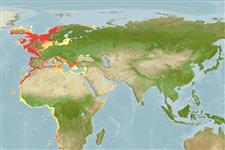分類 / Names
俗名 | 同種異名 | Catalog of Fishes(屬, 種) | ITIS | CoL | WoRMS | Cloffa
Elasmobranchii
板鰓亞綱 (鯊魚與魟魚) (sharks and rays) >
Rajiformes (Skates and rays)
鰩目 (Skates and rays) >
Rajidae (Skates)
鰩科 (Skates)
Etymology: Raja: Latin, raja, -ae = a sting ray (Raja sp.) (Ref. 45335).
More on author: Linnaeus.
Environment: milieu / climate zone / depth range / distribution range
生態學
海洋 居於水底的; 深度上下限 5 - 1020 m (Ref. 114953). 亞熱帶的; 70°N - 38°S, 25°W - 50°E
Eastern Atlantic and Southwest Indian Ocean: Iceland to Madagascar, including the Mediterranean Sea.
東大西洋: 冰島,挪威, 北海與波羅海西部向南至摩洛哥與那米比亞, 包括地中海與黑海。 雖然記錄自非洲南部, 在區域的它的狀態不確定.(參考文獻 5578)
Length at first maturity / 大小 / 重量 / 年齡
Maturity: Lm 76.6, range 47 - 87.5 cm
Max length : 105 cm TL 雄魚/尚未辨別雌雄; (Ref. 53748); 139.0 cm TL (female); common length : 85.0 cm TL 雄魚/尚未辨別雌雄; (Ref. 9987); 最大體重: 18.0 kg (Ref. 35388); 最大年齡: 15 年 (Ref. 41305)
背棘 (總數) : 0; 臀棘: 0. Sub-rhomboid in shape with pointed wing-tips; disc-width 1,25 to 1,36 times in its length, its length 1,70 to 1,83 times in total length. Short rostrum, rounded at his extremity; pectoral fins with clear angles on lateral side; triangular pelvic fins (Ref. 39246). Dorsally prickly; large females also prickly throughout their ventral surface; juveniles and large males prickly along the margins of their discs and the underside of their snout. 30-50 thorns form a median row from the nape to the first dorsal fin; additional large 'buckler' thorns with swollen bases scattered on upper surface of disc in adults (Ref. 3167). Coloration is highly variable, with the dorsal surface having all shades of brown with dark and light spots and blotches; ventral surface white (Ref. 3167, 58137).
上表皮長滿刺的, 下面長滿刺的在大的雌魚中, 只有吻與體盤邊緣當幼魚時與大的雄性; 眼窩的刺分開,30-50 在中央的從後頸到第一背鰭的列中; 附加的大 '圓盾' 刺用腫大的基底散佈在體盤上表面上當成魚時。 (參考文獻 3167) 接近長斜方形的體盤, 體盤-寬度 1,25 到 1,36 倍於體長, 它的長度 1,70 到 1,83 倍全長; 短喙,在他的末端圓的; 在側面的側邊上胸鰭有清澈的角; 三角形的腹鰭.(參考文獻 39246) 上表皮非常可變的, 所有的有褐色陰影, 雜色的具有深色與淡色的斑點與斑塊, 腹面白色的.(參考文獻 3167)
Inhabits shelf and upper slope waters. Reported depth ranges varies, from 10-300 m (Ref. 4426, 82319, 88187), and from 300-577 m in the eastern Ionian Sea (Ref. 56504); most common in coastal waters between 10-60 m depth (Ref. 58137). Tolerates low salinities (Ref. 88171). Found on mud, sand and gravel bottoms, rarely on rougher bottoms (Ref. 6808, 58137). Nocturnal species. Feeds on all kinds of bottom animals, preferably crustaceans (Ref. 3167) and fishes (Ref. 114953). Undertakes migrations with mean distances of 54-117 km per month; shows a clear annual migration cycle (Ref. 89017, 89018), moves from deeper offshore waters (10-30 m) in autumn and winter to shallower areas (<10 m) in spring (Ref. 82319). Young are non-migratory, inhabiting inshore nursery grounds (Ref. 89019, 89020, 89022); in the Bay of Douarnenez (France) they are found to remain in shallow waters for at least 2 years (Ref. 89023). Maturity age 7-8 years (Ref. 114953). Oviparous. Young may tend to follow large objects, such as their mother (Ref. 205). Detects weak electric fields generated by other organisms (prey detection and predator avoidance) but may also generate its own weak electric fields (Ref. 10311, 88171). Utilized fresh and frozen (Ref. 9987).
棲息於大陸棚與上層斜坡水域從海岸的線到大約 300 公尺。 棲息於沙子與砂岩底了。 (參考文獻 6808) 捕食各種的底部動物, 可能地甲殼動物.(參考文獻 3167) 卵生的。 明顯的成對出現。 幼魚可能傾向跟隨大的個體, 例如他們的母親.(參考文獻 205) 卵為長方形鞘囊具有僵硬的觸角沈積在沙灘或泥灘的角落.(參考文獻 205) 卵鞘是 5.0-9.0 公分長與 3.4-6.8 公分寬的.(參考文獻 41250) 生鮮使用與冷凍.(參考文獻 9987) 大約 52-170個卵在一年中每個體生產。 (參考文獻 41250) 給雄魚的最大長度是 105 公分TL 。 (參考文獻 41333)
Oviparous. Distinct pairing with embrace. Polyandrous species (Ref. 89024). Paired eggs are laid and deposited on shallow sand, mud, pebble or gravel bottoms (Ref. 205, 89025). Up to 170 egg cases can be laid by a single female in a year (Ref. 3167), but average fecundity is much lower (around 48-74 eggs) (Ref. 3603, 31302). In northwestern Europe, egg cases are laid during spring (Ref. 3167) and in the Mediterranean during winter and spring (Ref. 3167). Egg cases are oblong capsules with stiff pointed horns at the corners, each containing one embryo (Ref. 205). Capsules are 5.0-9.0 cm long without the horns (Ref. 41250, 88187) and 3.4-6.8 cm wide (Ref. 41250). Egg cases are anchored with an adhesive film (Ref. 82399). Embryos feed solely on yolk (Ref. 50449). Egg cases hatch after about 4-5 months and pups are about 11-13 cm TL (Ref. 88864). Mating season from February to September, peaking in June (Ref. 74501). Adults observed to form same-sex aggregations during the mating season with females moving to shallower inshore waters approximately a month before the males (Ref 3603, 58137, 74501). Mating does not occur in the Baltic Sea (Ref. 82311).東大西洋: 冰島,挪威, 北海與波羅海西部向南至摩洛哥與那米比亞, 包括地中海與黑海。 雖然記錄自非洲南部, 在區域的它的狀態不確定.(參考文獻 5578)
McEachran, J.D. and K.A. Dunn, 1998. Phylogenetic analysis of skates, a morphologically conservative clade of elasmobranchs (Chondrichthyes: Rajidae). Copeia 1998(2):271-290. (Ref. 27314)
人類使用
漁業: 商業性; 游釣魚種: 是的
工具
特別的報告
下載 XML
網路資源
Estimates based on models
Preferred temperature (Ref.
123201): 7.1 - 15.8, mean 10.7 °C (based on 474 cells).
Phylogenetic diversity index (Ref.
82804): PD
50 = 0.5000 [Uniqueness, from 0.5 = low to 2.0 = high].
Bayesian length-weight: a=0.00200 (0.00175 - 0.00228), b=3.26 (3.23 - 3.29), in cm total length, based on LWR estimates for this species (Ref.
93245).
營養階層 (Ref.
69278): 3.8 ±0.2 se; based on diet studies.
Generation time: 7.8 (5.4 - 10.4) years. Estimated as median ln(3)/K based on 16
growth studies.
回復力 (Ref.
120179): 低的, 最小族群倍增時間4.5 - 14 年 (K=0.09-0.14; tm=10; tmax=23; Fec=150).
Prior r = 0.18, 95% CL = 0.12 - 0.26, Based on 4 full stock assessments.
Fishing Vulnerability (Ref.
59153): High vulnerability (60 of 100).
Climate Vulnerability (Ref.
125649): High vulnerability (60 of 100).
Nutrients (Ref.
124155): Calcium = 9.22 [1.18, 176.74] mg/100g; Iron = 0.628 [0.060, 7.651] mg/100g; Protein = 17.2 [14.4, 19.5] %; Omega3 = 0.571 [0.265, 1.295] g/100g; Selenium = 39.7 [7.5, 183.1] μg/100g; VitaminA = 5.22 [0.40, 59.91] μg/100g; Zinc = 0.47 [0.03, 5.30] mg/100g (wet weight); based on
nutrient studies.
